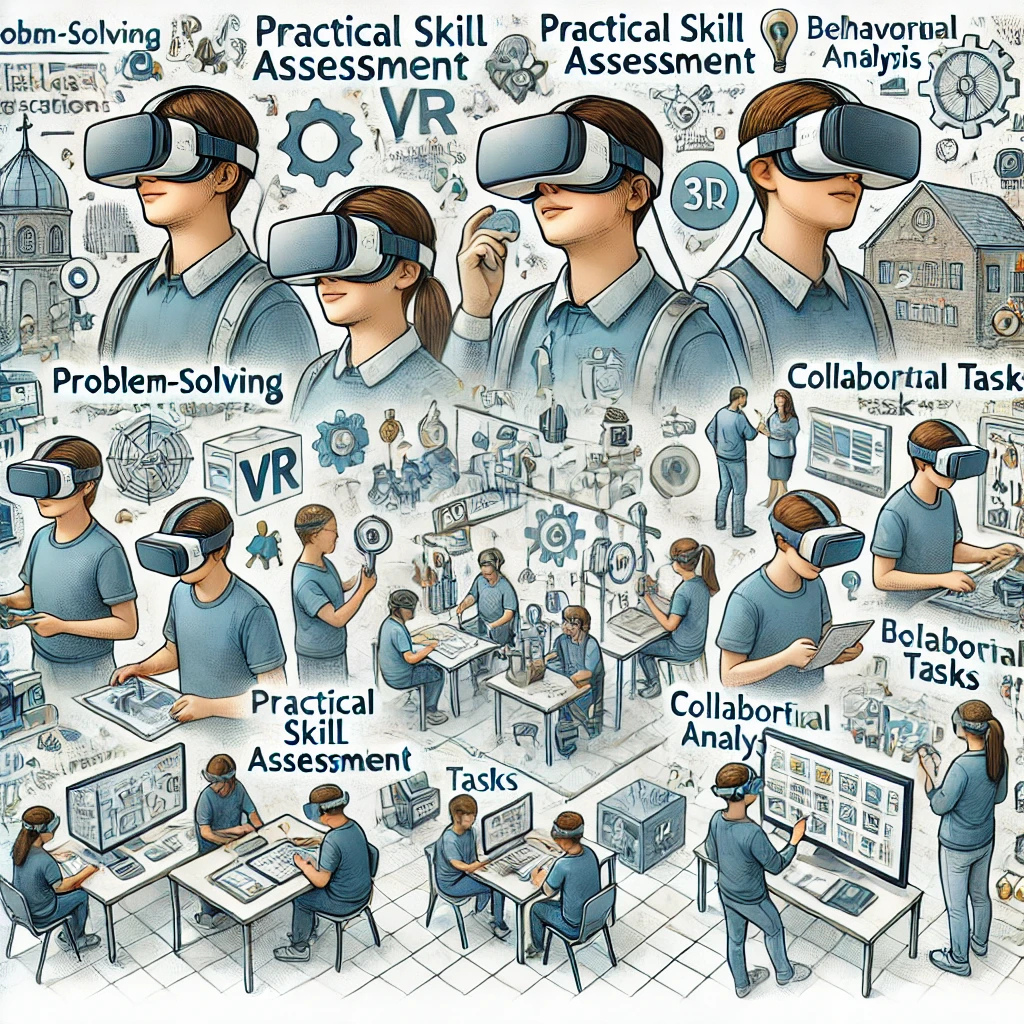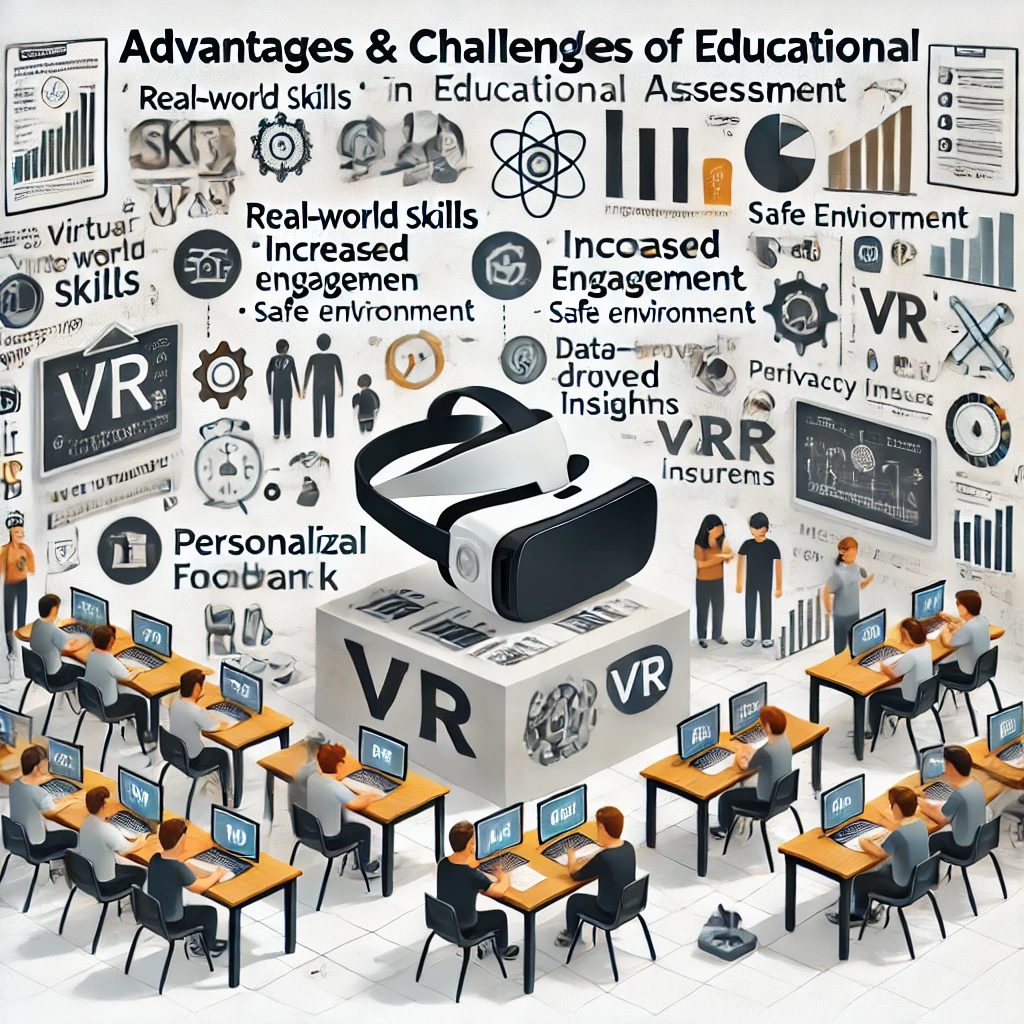Effectiveness of Virtual Reality in Educational Assessment
Virtual Reality (VR) is one of the recent transformative innovation technologies in the educational landscape. VR has been implemented across different fields like engineering, medicine, etc., beyond the gaming environment. It becomes a powerful tool, especially for student learning, since it provides a dynamic and engaging environment for interaction and communication while assessing the knowledge and performance of students. The evaluation of student learning outcomes has been changed in educational assessments with the use of VR (Hamilton et al., 2021). On the contrary, traditional assessment techniques like standardized exams and paper-based tests have not been completely evaluated the capabilities of students. Because, the conventional methods are limited in evaluating creativity and critical thinking as they focus on rote memorization. To overcome these disadvantages, educational institutions can integrate VR into educational assessments to improve student learning outcomes by evaluating their knowledge and decision-making skills. This marks a significant step in Educational Innovation aimed at transforming assessment practices (Asad et al., 2021). In this blog post, we will learn how VR is implemented for educational assessment, its advantages and challenges, and its future scope.
Virtual Reality (VR) and Its Adoption in Educational Assessment
VR technology allows students to experience three-dimensional environments through computer-generated simulations. Students can interact with these environments using VR headsets and controllers, allowing them to practice real-world skills in a controlled and safe environment. This immersive approach has become increasingly relevant in the era of Remote Learning, as educators can create real-time environments for students to learn concepts and perform tasks.

To evaluate the knowledge and skills of students, VR provides various opportunities for educational assessment. Some of the ways are included:
- Practical Skill Performance: The practical skill performance may not be effectively determined using traditional assessments, specifically in vocational education. This limitation can be addressed by using VR for handling real-time tasks and practical assessments. For instance, concepts like VR in Healthcare demonstrate how immersive simulations enhance hands-on learning. Safety techniques and construction methods can be learned by students in a construction site through a virtual and real-time immersive environment (Rokooei et al., 2021).
- Simulated Problem-Solving: The simulated problem-solving would be provided in VR environments so that students can solve complex problems. For instance, engineering students can solve issues with the equipment in a virtual factory. Similarly, virtual surgery environments allow students to make crucial decisions in real-time (Sánchez-Margallo et al., 2021).
- Collaborative Assessments: Creating collaborative assessments is one essential application of VR, which helps students to complete tasks by working together. However, educators can evaluate how students can communicate and collaborate in a team.
- Behavioral Responses: In addition, behavioural responses can also be assessed using VR. For example, teachers can find out how students interact within a virtual classroom. The concept of analyzing interactive behavior has also gained importance in AI in Fitness applications, where user engagement and feedback are continuously monitored to improve personal fitness outcomes. The management behaviour of teachers, including responding to student queries and engaging with learners, can be assessed based on VR technology.
Advantages of VR in Educational Assessment
The major benefits of VR applications in assessments are real-world skills, increased engagement, a safe learning environment, personalized learning and feedback, and data-driven insights. VR facilitates improved student engagement and reduces their test anxiety by providing a fun and game-like environment. Often, it is complex to assess standard exams in a real-world application, which is made easier with the use of VR assessments. However, teachers can understand student learning in real-world contexts by reinforcing learning through virtual experiments. Moreover, VR offers a safe learning environment for students to engage with the tasks without any consequences in real time. In simulated assessments, life-saving procedures can be practiced by medical students that would assist them in reducing their fear of harm. Innovative Teaching approaches like these enhance personalization by providing detailed and immediate feedback based on performance, enabling personalized learning pathways through VR systems (Marougkas et al., 2024). Data-driven insights can be provided by collecting data relevant to emotional responses, decision-making, and reaction times using VR. It can also be utilized to track students' growth.
Involved Challenges of VR in Educational Assessment
The application of VR in educational assessment can also come with challenges:
- Cost: The technology of VR and its implementation in educational institutions is an expensive process due to the required significant investments in VR headsets and computers. If education systems with limited budgets, they would be less accessible for VR technology, especially in developing countries. This financial limitation also affects research domains such as PhD Thesis Writing, where access to cutting-edge tools like VR can enhance experiential learning but remains out of reach for many (Fransson et al., 2020).
- New Metrics for Evaluation: It requires significant development and measurement of new metrics for evaluation to ensure that the educational assessments are computed accurately.
- Technical Familiarity: Students and educators need to be familiar with the use of VR technology because there might be a chance of causing issues with the performance of a system, such as hardware malfunctions or software bugs.
- Data Privacy: Educational institutions should ensure robust ethical data collection and privacy protections to prevent misuse of sensitive data about students.

Conclusion
Virtual Reality offers interactive and immersive real-time environments for students to make educational assessments more effective and relevant while implementing the knowledge in real-world contexts. It also enables customized educational assessments based on the learning requirements of students and provides actionable feedback. In despite of these benefits, high costs, reliable assessment, and technical difficulties are significant challenges of VR adoption in educational settings. To restrict these issues, educators, policymakers, and developers should collaborate to implement VR as an effective tool in teaching and student learning. As highlighted in Key to Developing a Culture of Leadership, innovative strategies and collaboration are essential for integrating new technologies. Although VR application is in the early stages of education, it creates new opportunities for the educational landscape based on practical and engaging evaluations in real-time assessment.
References
- Asad, M. M., Naz, A., Churi, P., & Tahanzadeh, M. M. (2021). Using immersive technologies to enhance the student learning experience. Emerald.Com, 2021. https://doi.org/10.1155/2021/7061623
- Fransson, G., Holmberg, J., & Westelius, C. (2020). The challenges of using head mounted virtual reality in K-12 schools from a teacher perspective. Education and Information Technologies, 25(4), 3383–3404. https://doi.org/10.1007/S10639-020-10119-1
- Hamilton, D., McKechnie, J., Edgerton, E., & Wilson, C. (2021). Immersive virtual reality as a pedagogical tool in education: a systematic literature review of quantitative learning outcomes and experimental design. Journal of Computers in Education, 8(1), 1–32. https://doi.org/10.1007/S40692-020-00169-2
- Lanzieri, N., McAlpin, E., Shilane, D., & Samelson, H. (2021). Virtual Reality: An Immersive Tool for Social Work Students to Interact with Community Environments. Clinical Social Work Journal, 49(2), 207–219. https://doi.org/10.1007/S10615-021-00803-1
- Marougkas, A., Troussas, C., Krouska, A., & Sgouropoulou, C. (2024). How personalized and effective is immersive virtual reality in education? A systematic literature review for the last decade. Multimedia Tools and Applications, 83(6), 18185–18233. https://doi.org/10.1007/S11042-023-15986-7
- Rokooei, S., Professor, A., Mahdavian, A., Carson, L., Clinical Professor, A., & Ford, G. (2021). Using immersive video technology for construction management content delivery: a pilot study. Itcon.Org, 26, 886–901. https://doi.org/10.36680/j.itcon.2021.047
- Sánchez-Margallo, J. A., Plaza de Miguel, C., Fernández Anzules, R. A., & Sánchez-Margallo, F. M. (2021). Application of Mixed Reality in Medical Training and Surgical Planning Focused on Minimally Invasive Surgery. Frontiers in Virtual Reality, 2. https://doi.org/10.3389/FRVIR.2021.692641/FULL